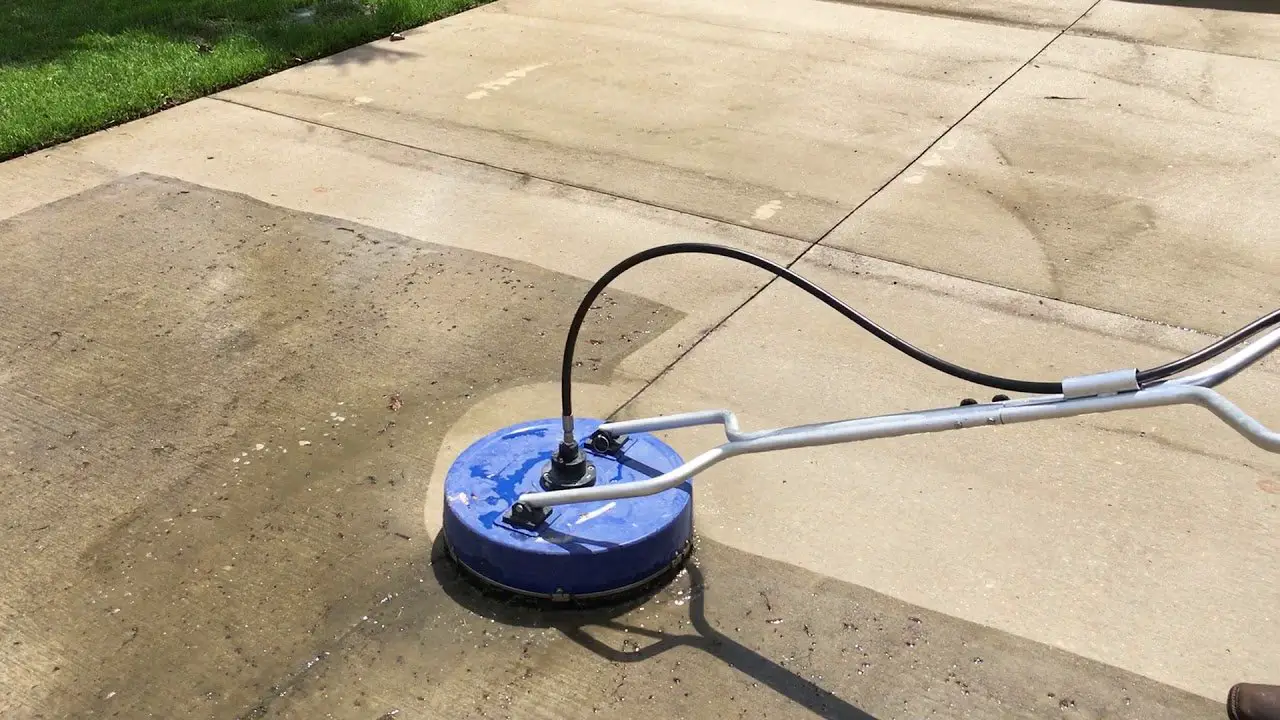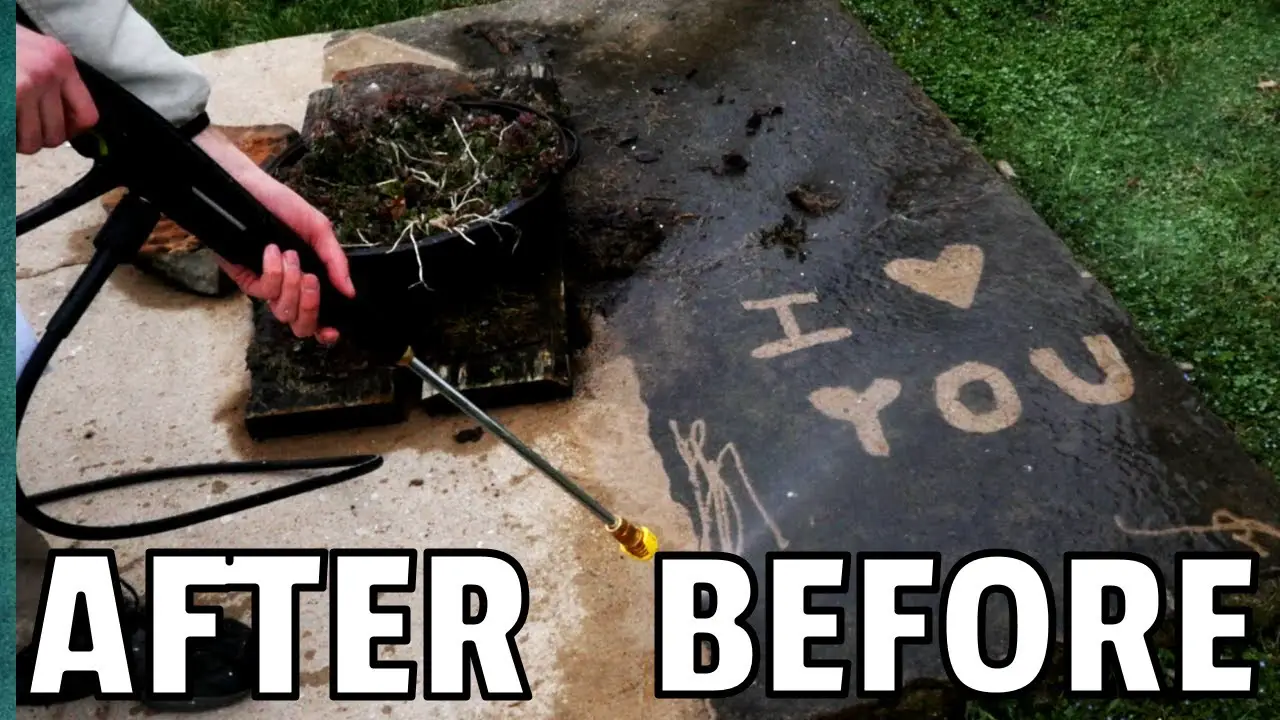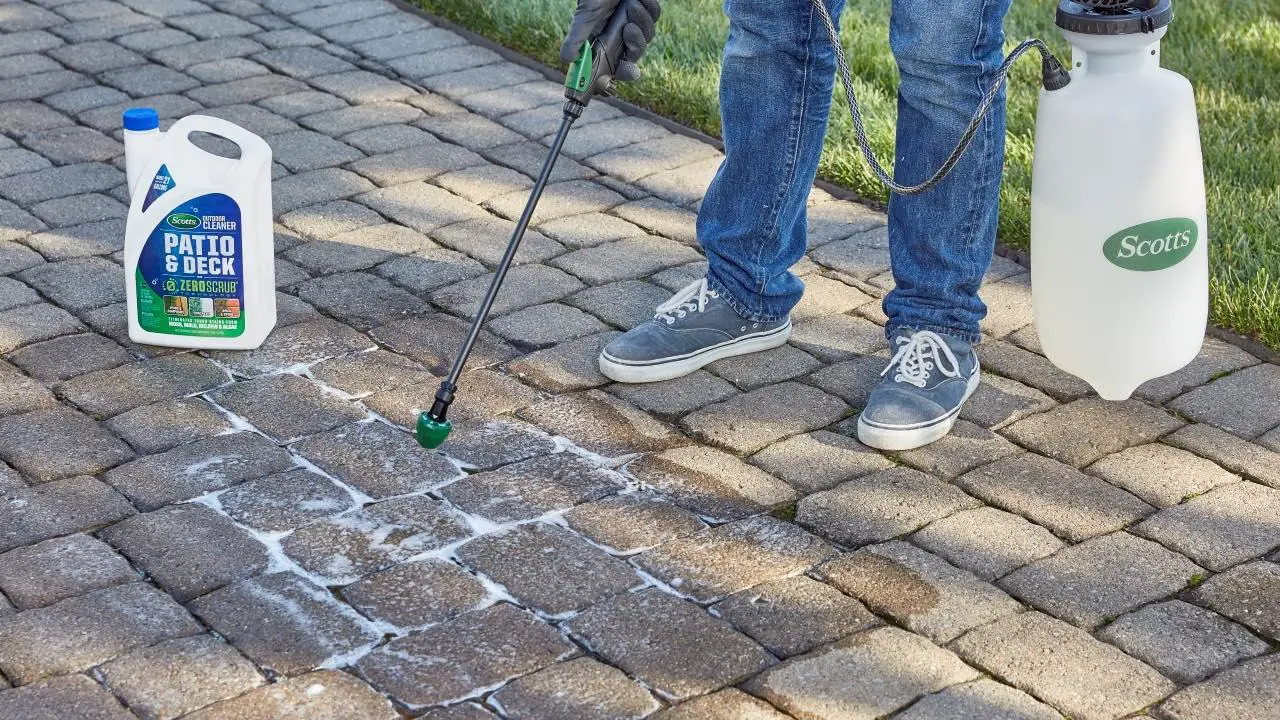Fallback On Commercial Cleaning Products
If vinegar or bleach do not work, or you would prefer to move directly to a commercial solution, you should have no trouble finding effective products at your local garden center or home improvement store.
You can opt for a simple patio or deck wash-type of product that is used for general cleaning if your mold or algae problem is mild. If your hardscape has been stained from the mold or algae, you may need to opt for a mold stain remover. For example, if you just purchased a home where mold or algae has been allowed to flourish for an extended period of time on concrete, brick or paving stones, there may be stains that require a product specifically designed for mold and algae stain removal.
With most of these products, you will spray the area, allow it to work its magic for a few minutes, scrub with a deck brush or push broom, and then rinse the area with water.
Enlist A Power Washer
If the stain persists, try a pressure washer. You can buy attachments that convert your garden hose into a power washer or rent a machine from your local hardware store. If you rent a machine, step up the pressure carefully as needed, so you dont inadvertently damage the concrete. Dont forget to don safety goggles and protect windows, plants, and the like, as the water pressure can damage them.
For more specific concrete stains, follow this guide:
The Mildew And Concrete Problem
Mildew is a type of mold which usually appears as a thin or fine dusting of a black, grey, or sometimes white growth. Mildew relies on three essential elements for growth moisture and food. Although your concrete is not a direct source of food, that unsightly mildew gets fed plenty of essential nutrients by the fine layer of dust that sits on the surface of your patio, path or walls. The same goes for the temperature requirements of mildew its happy to grow in any temperature you live in. And of course, concrete is also a major moisture magnet!
Outdoor mildew can grow on hard surfaces such as concrete patios or the floors of your basement. Not only can mildew ruin the appearance of your concrete and make the surface slick and slippery, it can also become a health hazard. Some people have allergies or sensitivities to mildew which can result in serious reactions, especially in people who have weak immune systems or respiratory conditions. For many reasons, if you have an issue with mildew, you want it gone, and quickly.
Recommended Reading: Mold Cleaner For Ceiling
Water Stains Mold And Mildew
Cleaning concrete floors in a basement that is has a mold or mildew problem is different from cleaning a concrete patio with the same issue. If you have a mold or mildew problem on your basement floor, do not sweep the areayoull end up spreading mold spores around the basement, causing a much bigger problem.
Open any windows and allow fresh air to circulate while cleaning. Spray the problem area with a solution of mold-killing detergent and water , scrub the area with a brush, and rinse with a clean wet mop.
Once the area is completely dry, examine it to determine if you need to repeat the process.
To remove water, mold, or mildew stains from concrete patios and driveways, use a hose or pressure washer. If stains persist, mix a solution of one-quarter bleach to one gallon of hot water and scrub the area with a brush, watering down nearby foliage first to prevent damage from runoff. Rinse thoroughly with clean water.
How To Remove Mold And Mildew From Concrete

Nothing hurts a proud homeowner’s pride quite like a driveway overrun with mold and mildew stains. If your driveway is always in the shade, or you live in a damp climate, it’s only a matter of time before your driveway falls victim to a mildew attack.
It’s frustrating to try hosing mold away and watch it reappear moments after. Scrubbing it off with a push broom doesn’t help much either. Below we cover two effective options for removing mold and mildew from concrete.
- Garden hose
*Pro Tip: Water your lawn well before cleaning to minimize bleach absorption.
Before you begin cleaning, wear rubber gloves. Combine 1/4 cup of liquid bleach with 1 gallon of hot water in a large bucket. To avoid damaging your lawn or walkways, always dilute your bleach and control your runoff when rinsing.
Soak your brush in the solution and scrub the entire area until it’s fully saturated. Let it soak before cleaning it up. Never put bleach in your pressure washer, as it’ll ruin it.
Also Check: Cleaning Mold From Bathroom Ceiling
Solving The Mildew Problem
With all this in mind, it makes sense that you should avoid bleach when tackling your mildew. So how can you successfully remove mildew stains without reaching for the bleach? Follow our simple tips below:
Make a Water and Vinegar Solution
A homemade water and vinegar solution is one of the most effective ways of creating an inhospitable environment for mildew spores and removing mildew from concrete.
Heres our step-by-step guide on how to do it:
Continue with this method once a week until the problem has completely subsided.
Apply Water Pressure
Privacy Overview
How To Remove Fertilizer Stains From A Concrete Driveway
Lawn and plant fertilizers contain metals and minerals that can leave rust-like stains on a concrete driveway. These may even result in permanent color change if they are allowed to penetrate. To bring out the stains, try applying distilled white vinegar diluted 50:50 with water. If the vinegar doesnt work, you may need to use something stronger, such as muriatic acid diluted 40:1 with water.
Tip: Be aware that acidic cleaning solutions may etch or change the profile of the concrete in the areas you clean. Test them out in a small area first.
You May Like: Ozone Machine To Kill Mold
Tools And Protective Gear
Black mold removal requires a few household tools and some more advanced protective gear. Youll need a bucket, bleach, disposable rags, rubber gloves, heavy-duty garbage bags to dispose of contaminated material, and a wire scrub brush. Its also necessary to use good protective gear. For black mold, an N-95 respirator is the minimum advised. Youll also need goggles to protect your eyes from spores in the air.
How To Safely Clean Your Exposed Aggregate Driveway
Here are some general tips for cleaning an exposed aggregate driveway. If youre using a store-bought chemical cleaning product, ensure you read and follow the instructions on the product.
For every stain that occurs on exposed aggregate, your cleaning process starts with sweeping away all of the surface dirt, debris and other material that is going to stop you from removing the stain.
Put on your protective clothing: safety/glasses/goggles, water-resistant gloves, water-resistant boots and a mask.
Further clean the exposed aggregate with water using a garden hose or, if available, a high-pressure cleaner. Be very careful when choosing to use a high-pressure cleaner on exposed aggregate as if your pressure is too high, you can cause damage to the cement and the loosen the stones from your driveway. View our guide for advice on what pressure to use when cleaning your exposed aggregate driveway.
Apply a driveway cleaning chemical or water-based cleaner, depending on the type of stain you have. Before you apply the driveway cleaning solution, carefully read the instructions and warnings on the product. We recommend speaking to someone at the hardware store or seeking a quote from a Perth driveway cleaning company before attempting DIY driveway cleaning.
Leave the solution on your driveway for the recommended time from the cleaning product instructions.
If the stain remains after scrubbing, refer to the driveway cleaning product to see if you can reapply the product.
Don’t Miss: Fungus On Leather
Do Protect Your Concrete After Cleaning
Consider sealing your concrete surfaces after they have been properly cleaned. Be sure to research the best product and application for your job and to test it out before sealing the entire area. Consider:
While we may not think about it, we come into contact with concrete every day of our lives. Help to preserve your walks, drives, and even décor with these tips and your outdoor spaces will look great for years to come.
Have questions about cleaning concrete? Leave a comment below!
-
30 SECONDS Cleaners are proudly made in the USATroutdale, Oregon and Manchester, Tennessee
-
30 SECONDS Cleaners are proudly made in the USATroutdale, Oregon and Manchester, Tennessee
What Are Some Of The Other Causes For Culvert Failure
If your culvert becomes blocked and is not cleared, culvert failure can occur. It is important to perform routine maintenance to help prevent clogs and culvert failure. Culverts can also fail due to installation-related mistakes, volume and capacity issues, and even certain environmental factors based on the areas in which they are located.
Also Check: Remove Mold Bathroom Ceiling
Cleaning Starts With Prevention
The best way to keep your concrete clean starts with prevention, which means sealing the concrete and keeping the surface clean. Sealing new or freshly cleaned concrete slabs, walkways and pavers help prevent stains from forming, according to Peacock Pavers. Plan on annually cleaning the concrete and reapplying the sealer to the concrete every five years. When cleaning, start by thoroughly wetting the area before using a mild, nonacid cleaning solution to wash your concrete patio and walkways.
Regular maintenance routines will greatly reduce the need for using chemicals to clean stains. Sweep off leaves to prevent tannin stains and wipe up spills quickly, especially liquids like wine or coffee. Use a non-wire, stiff-bristled brush or broom when sweeping away leaves and dirt or scrubbing out weeds and mold because wire bristles will scratch the sealant and concrete surface. Prevent rust stains by regularly checking wrought-iron patio furniture to be sure the metal is sealed.
Option Three: Use Culvert Cleaning Tool To Clear Blockage

A culvert cleaning tool is powerful thanks to its hoe-type head that pivots, helping to extract debris. Insert the head of the tool into the blockage and begin loosening the debris causing the blockage. Remember, you want to loosen the debris and remove it without damaging the culvert.
- Pro Tip: If this method is working, keep repeating this process until the clog is removed. Culvert clogs are stubborn, and a little elbow grease may be required to fully clear the blockage.
Don’t Miss: How To Remove Mold Off Bathroom Ceiling
Cleaning Concrete With Cola
Cola and other dark sodas have two major components that help fight stains. The acid breaks down the fluid that caused the stain, while the carbonation lifts the debris to the surface for easier cleaning.
- Bristle brush
Wet the stained area with water. Sprinkle the powder detergent over the spot and let sit for one hour. Bring a large pot of water to a boil while you wait.
Once boiling, take the pan outside and pour the hot water over the stain. Scrub the area with a bristle brush. Rinse the area with fresh water once finished. Repeat as often as necessary.
How To Keep A Concrete And Paver Patio Dry
For you to keep and paver patio dry and clean, you need to do the following:
You May Like: How To Remove Molds From Leather
How To Prevent Mold On Concrete
Preventing black mold from entering your home is fairly straightforward, although it requires staying on top of the situation. Because fungus loves to flourish on damp areas, make sure rooms with regular water exposure like the kitchen and bathroom are well-ventilated. Dehumidifiers are helpful is small rooms with high humidity levels. Always check for leaking pipes as well, which are a major cause of household mold. Preventing mold in the basement is a bit trickier. Youll need to make sure ground water runs away from your home to prevent it from collecting near the basement. Check that sprinklers and downspouts arent depositing water near the basement walls or windows. Prevent condensation on basement water pipes by wrapping them. Use an exhaust fan in the bathrooms of your home after showering. Finally, keep the humidity in your basement below 60%. Running a dehumidifier downstairs may be your only option if you live in an area with high humidity.
So The Million Dollar Question Is Can You Clean Concrete Driveway With Bleach In Hunterdon County
We provide driveway cleaning quotes in hunterdon County NJ for a living. We know what works and what doesnt work so well.
Concrete driveways are prone to dirt, residue, mold or mildew. Yes, you can clean them with bleach. In fact, bleach not only removes many stains, but it also deodorizes and kills mold and mildew when used properly.
However, there are few things you need to know first.
Recommended Reading: How To Get Rid Of Mold On Bathroom Ceiling
General Maintenance Of Concrete Floors
Concrete floors should be cleaned at least once a year to keep them in tip-top shape. Before starting, remove any items from the areaif its an outdoor patio, remove all potted plants, furniture, and decorative items. Do a spot test by testing your cleaner in an inconspicuous area to ensure your method will not cause any additional discoloration or damage to your concrete.
To clean a concrete floor in your basement, you may need to do it in sections by moving everything from one side of the room to the other, and then switching back to finish the job.
Inspect your floors for cracks or chips and make any necessary repairs before beginning the cleaning process.
What Kills Black Mold On Concrete
Dont Miss: Getting Mold Off Bathroom Ceiling
You May Like: Removing Mildew From Bathroom Ceiling
How To Get Rid Of Mold On Concrete Basement Walls And Floor
When mold is found in the interior of a home, its a much bigger deal because of the serious health hazards of black mold. For more extensive interior mold problems, it may be best to hire a professional mold mitigation service for removal.
If thats not in the budget or youve discovered the problem while its still relatively small, you can do it yourself.
Begin by protecting yourself. Because mold can affect the respiratory system, its best to use a high-quality respirator to block out mold spores. Also, use rubber gloves and goggles for eye protection.
Create either a bleach solution or a solution of detergent and water. The Environmental Protection Agency suggests the latter as detergent can better penetrate concretes porous surface than bleach.
For thorough cleaning, use trisodium phosphate, an industrial-grade detergent that will kill mold and remove grease and grime. Apply the cleaner with a brush and scrub thoroughly to remove the mold and engage the roots. Wipe clean.
Once clean, use a bleach or vinegar solution and allow the solution to dry on the wall or floor. This will serve as a preventative to keep the mold from returning.
Read Also: Clean Moldy Leather
Cleaning Leaf Stains From A Driveway

Stains on concrete driveways from leaves, grass, tree sap, and other organic materials can be tough to remove. They typically require special cleaners formulated for the removal of organic stains. These cleaners typically do not affect the concrete color or harm the surface because the enzymes only target organic material.
Follow these steps:
Don’t Miss: Getting Rid Of Mold On Bathroom Ceiling
